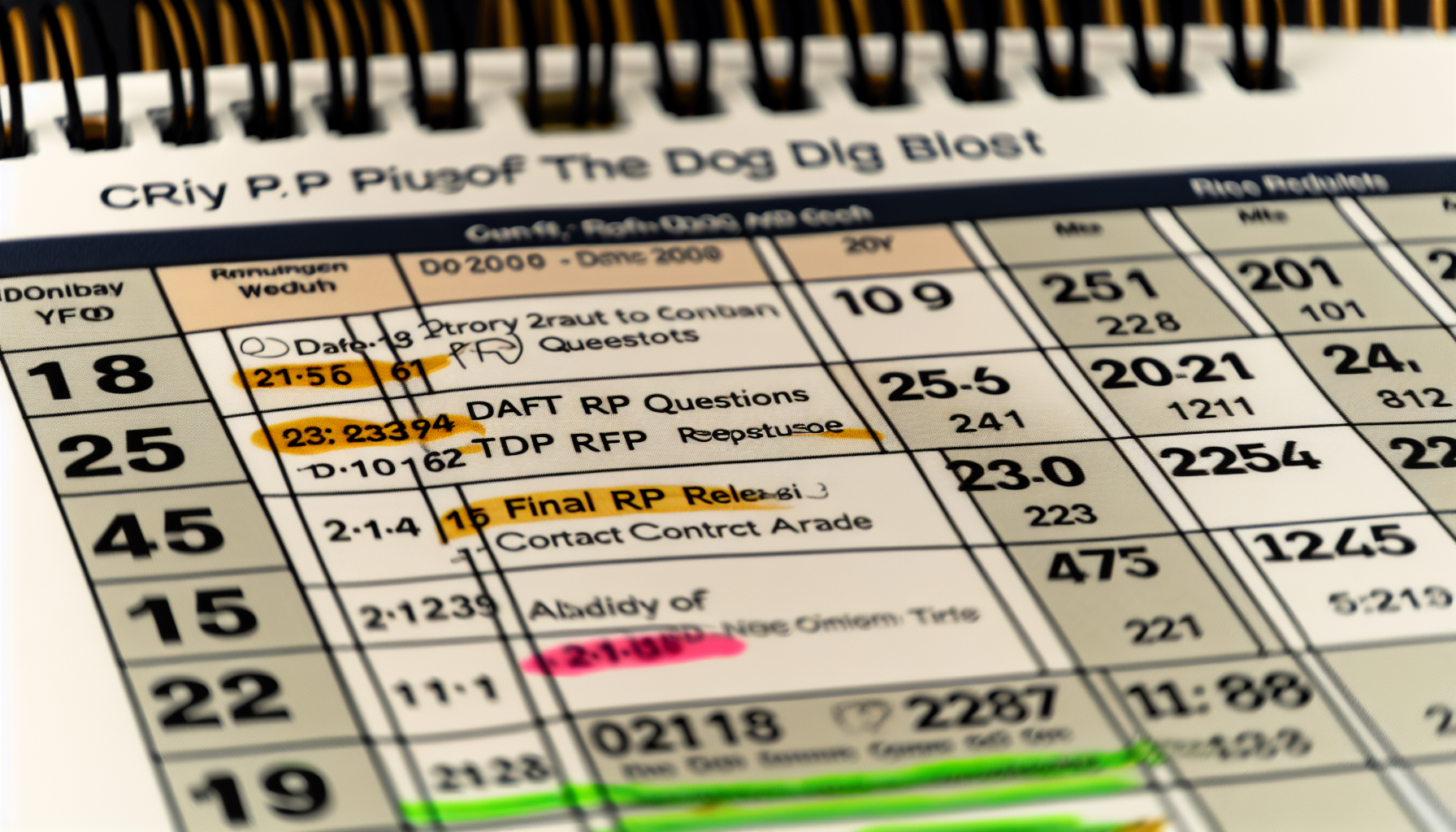Alliant 3
As we embark on a new era of technological advancements, the General Services Administration (GSA) is keeping pace by introducing the Alliant 3 Contract Vehicle - an innovative approach to federal IT procurement. This contract vehicle, designed to meet the evolving needs of federal agencies, is more than just a procurement tool; it is a launchpad for businesses to broaden their horizons and capitalize on the growing demand for advanced IT services in the federal market.
Key Takeaways
- The Alliant 3 Contract Vehicle is a comprehensive IT solution with a focus on emerging technologies, offering contractors access to a federal market with an estimated $75 billion contract ceiling for advanced IT services procurement.
- Contractors aiming for success with Alliant 3 must prepare thoroughly by understanding the self-scoring evaluation system, demonstrating relevant experience with high-value projects, and showcasing expertise in emerging technologies to earn additional points.
- The Alliant 3 Contract presents subcontracting opportunities, particularly for small businesses, which are encouraged with a 50% subcontracting goal, and businesses must strategically prepare for RFPs, provide feedback, and stay informed to maximize their chances for success.
Understanding the Alliant 3 Contract Vehicle

The Alliant 3 Contract Vehicle, the latest iteration of the Best-in-Class (BIC) Government-wide Acquisition Contracts (GWAC), is a testament to the GSA’s commitment to staying ahead of the curve. It is a comprehensive solution designed to meet the increasingly complex IT requirements of federal agencies. With a focus on both current and emerging technologies, it marries compliance with flexibility, making it a prime choice for agencies seeking advanced IT solutions.
For contractors, the Alliant 3 Contract Vehicle opens up a unique avenue to penetrate a potentially expansive market. With an estimated contract ceiling of $75 billion, the Alliant 3 Contract Vehicle is set to make a significant impact on the federal marketplace. Regardless of your status as an established Alliant 2 contractor or a newcomer, the Alliant 3 Contract Vehicle provides an opportunity to exhibit your skills and obtain a share of the federal IT procurement market.
Key Features of Alliant 3
One of the standout features of the Alliant 3 Contract Vehicle is its focus on emerging technologies and defense information enterprise architecture. The draft RFP includes a variety of these, including:
- Artificial Intelligence (AI)
- Big Data
- Cloud Computing
- Health Information Technology (HIR)
These are not mere buzzwords but vital tools that are shaping the future of IT services. By incorporating these technologies, the Alliant 3 Contract Vehicle positions itself at the forefront of the IT services market.
But why does this matter to contractors? It’s simple. By demonstrating expertise in these emerging technologies, contractors can not only earn additional points in the evaluation process but also position themselves as leaders in the field. This can pave the way for a plethora of opportunities, enabling the provision of advanced IT services like AI, distributed ledger technology, and robotic process automation.
And with the importance of Big Data and Cloud Computing in the Alliant 3 contract, contractors have the potential to tap into a vast and growing market, including computer facilities management services.
Impact on Federal Market
The Alliant 3 Contract Vehicle holds the potential to significantly reshape the federal marketplace. As a governmentwide acquisition contract (GWAC) designed for advanced IT services procurement, it offers competitive pricing and pre-approves vendors for the provision of IT services. With an estimated ceiling of $75 billion, the Alliant 3 Contract Vehicle’s impact is expected to be far-reaching, offering a wide provision of IT services across the federal government.
The impact also permeates the competitive landscape. The Alliant 3 Contract Vehicle is anticipated to intensify competition in the federal market with several companies vying for a place on the GWAC. This means that no matter the size or scope of your business, the Alliant 3 Contract Vehicle presents an opportunity to compete on a level playing field, opening up a world of possibilities for growth and success.
Preparing for Alliant 3: Evaluation Factors and Scoring

Securing a contract under the Alliant 3 Contract Vehicle is no small feat. It requires careful preparation and a deep understanding of the evaluation factors and scoring system. The GSA intends to utilize a self-scoring approach for Alliant 3, which evaluates the proposals of offerors through the Document Verification and Self Scoring Worksheet. This implies that every aspect of your proposal is significant and could determine the distinction between triumph and failure.
If there is a tie at the 60th award, all offerors with identical scores will receive an award. This ensures fairness in the selection process. This underscores the importance of every point in the evaluation process. Offerors are allowed to demonstrate a maximum of seven primary relevant experience projects and three Emerging Technology-Relevant Experience (RE) projects. Early preparation and strategizing are crucial to ensure a comprehensive understanding of the evaluation factors and enhance the potential for success.
Meeting Past Performance Requirements
Past performance plays a significant role in the Alliant 3 evaluation process. To meet the criteria for relevant past performance or experience, a project must have a minimum monetary value of $7 million. This threshold underscores the importance of having a strong track record in delivering high-value projects. If your past performance portfolio falls short of this threshold, you could adopt strategies like concentrating on higher-value projects, entering partnerships, and pursuing more contracts.
In addition to the monetary value, the nature of the project also matters. The principal NAICS Code specified for the Alliant 3 contract is 541512, which encompasses projects associated with computer systems design services and custom computer programming services. So, when preparing for Alliant 3, it is important to focus not just on the size of your past projects, but also on their relevance to the contract requirements.
Showcasing Relevant Experience and Emerging Technologies
In the Alliant 3 Contract Vehicle, showcasing relevant experience and proficiency in emerging technologies can give you a competitive edge. Contractors can obtain additional points for each supplementary emerging technology experience they possess, including:
- AI
- Big Data
- Cloud Computing
- Extended Reality (XR)
- Health Information Technology (HIR)
- Internet of Things (IoT)
- Mobile IT
- Quantum Computing
- Zero Trust Networks
Successful implementations of artificial intelligence, cloud computing, and cybersecurity initiatives are highly regarded within the Alliant 3 evaluation. To qualify for additional points for emerging technologies, individual projects must have a minimum value of $1 million. ‘Relevant experience’ pertains to prior work that demonstrates your proficiency and skill in providing services that align with the specifications outlined in the Alliant 3 contract. By showcasing such projects, you can provide evidence of your capacity to effectively fulfill the contract’s requirements.
Subcontracting Opportunities and Small Business Goals

The Alliant 3 Contract Vehicle also presents substantial subcontracting opportunities, especially for small businesses. The small business subcontracting goals for Alliant 3 aim for 50% of subcontracting dollars to be allocated to small businesses. This provides a chance for small businesses to partake in the federal IT procurement process, thereby expanding their operations.
Small businesses stand to gain significantly from the Alliant 3 Contract Vehicle, with enhanced business prospects, the potential to establish Contractor Teaming Arrangements (CTA) and Joint Ventures (JV), and access to a broader contract ceiling. To qualify as a subcontractor, businesses must meet the small business subcontracting goals as outlined in Section G of the contract and have relevant past performance or experience in projects meeting a minimum value requirement.
Benefits for Small Businesses
The Alliant 3 Contract Vehicle is designed to foster the growth and development of small businesses. It does this by:
- Placing a greater emphasis on small businesses through subcontracting plans
- Introducing performance standards and evaluation factors that favor small businesses
- Enabling small businesses to procure advanced IT services and expand their operations
The Alliant 3 Contract Vehicle also allows small businesses to participate in contract competitions on an equitable basis. This opportunity is extended to businesses, including those that are veteran-owned or service-disabled veteran-owned, and HUBZone businesses, which can potentially secure up to 60 contracts allocated specifically for them, contingent upon meeting self-scoring requirements. This allocation serves to augment their visibility and impact in the federal marketplace.
Tips for Successful Subcontracting
Achieving success in subcontracting under the Alliant 3 Contract Vehicle necessitates a strategic approach. Contractors can optimize subcontracting opportunities by:
- Utilizing Contractor Teaming Arrangements (CTA) and Joint Ventures (JV)
- Aiming to meet the subcontracting goal of 50% for small businesses
- Generating a high-scoring proposal
- Staying informed about updates or opportunities related to Alliant 3
- Collaborating with small and disadvantaged businesses.
However, subcontracting under Alliant 3 can also present challenges, such as worker shortages, time constraints, government regulation, payment issues, lack of communication, and document management. These difficulties can be addressed by establishing a skilled worker network, effectively managing time and resources, staying informed about regulations, setting clear payment terms, fostering open communication, and implementing efficient document management systems.
Alliant 3 Timeline and Important Dates

Understanding the timeline and key dates related to the Alliant 3 Contract Vehicle is crucial for successful participation. The anticipated components to be included in the draft RFP for Alliant 3 are:
- Section C, Descriptions, Specifications, & Statement of Work
- Section L, Instructions, Conditions, & Notices to Offerors
- Section M, Evaluation Factors for Award, Cybersecurity, and SCRM References
At our company, we offer a wide range of services, including software development, network management, and other computer related services, among others.
The important dates to remember for the Alliant 3 contract process are:
- Deadline for submitting feedback on the draft RFP: January 31, 2023
- Expected release date for the final RFP: May 2023
- Virtual pre-proposal conference: Date to be communicated through SAM.gov
Monitoring these dates can guarantee your preparedness for each stage of the contract process.
Preparing for the Official RFP
As the release of the official RFP approaches, adequate preparation is key. The standard format for an Alliant 3 RFP includes:
- Forms such as SF-33 and SF-30 for amendments
- A document verification and self-scoring worksheet
- An evaluation that utilizes the Highest Technically Rated Offerors with a Fair and Reasonable Price approach.
To get ready for the Alliant 3 RFP, it is important to identify relevant experience projects, evaluate and strategize early, create a proposal execution plan, and conduct an organizational risk assessment. Utilize Enhanced Task Order Competition authority, and ensure proper management of GSA Schedule. It’s also crucial to avoid common pitfalls such as neglecting to conduct research on customers and competitors, failing to respond to the Request for Information (RFI) or attend the Industry Day, and providing suppliers with insufficient time to prepare proposals. Additionally, consider implementing supply chain risk management to further strengthen your proposal.
Providing Feedback on Draft RFP
Providing feedback on the draft RFP is an integral part of the Alliant 3 process. Your comments and suggestions can contribute to shaping the final version of the contract. The most effective method for submitting feedback on a draft RFP for Alliant 3 is to send your comments and suggestions to A3draftRFP@gsa.gov.
However, providing feedback requires a thoughtful approach. Potential challenges to be mindful of when giving feedback include:
- Inadequate research on customers and competitors
- Failure to respond to the Request for Information (RFI) or attend the Industry Day
- Bidding for inappropriate reasons
- Neglecting to review the eligibility requirements
By addressing these challenges, you can offer meaningful input that contributes to the development of the Alliant 3 Contract Vehicle.
Strategies for Success in Alliant 3 and Beyond

Although the Alliant 3 Contract Vehicle offers a distinctive opportunity, clinching a contract demands a strategic approach. Key strategies for success include:
- Evaluating your past performance portfolio
- Identifying suitable teaming partners
- Closely monitoring the opportunity pipeline
- Actively pursuing opportunities
- Establishing a strong past performance record
- Strategically utilizing data and technology
- Establishing alliances or partnerships
- Staying informed about Alliant 3 updates.
These strategies are not limited to the Alliant 3 Contract Vehicle. The skills and experiences gained through Alliant 3 can be leveraged for other significant government opportunities. By demonstrating a history of project delivery, you can establish trust with other agencies and position your business for future success.
Partnering with Expert Support
Collaborating with seasoned consultants and solution services can markedly boost your odds of success in Alliant 3. Consultants provide essential support to contractors by offering expert guidance, aiding contractors in fulfilling complex requirements, selecting suitable teaming partners, crafting compelling proposals, and devising an effective overall strategy.
Lohfeld Consulting Group and Baker Tilly are among the notable consulting firms specializing in providing support for the Alliant 3 contract. By leveraging their expertise, you can navigate the Alliant 3 process more effectively and increase your chances of securing a contract.
Staying Informed and Adapting to Changes
In the ever-changing federal market, keeping abreast of Alliant 3 developments and adjusting to changes is vital. Here are some strategies to help you stay ahead of the curve and adapt to changes effectively:
- Monitor the General Services Administration (GSA) website for updates
- Engage in regular communication with the GSA and stakeholders
- Adhere to government memos and guidelines
- Seek clarification on proposal submissions to guarantee compliance
- Gather insights from industry experts regarding the acquisition strategy
By following these strategies, you can stay informed and navigate the Alliant 3 process successfully.
The need for continuous learning and adaptation does not end with Alliant 3. As the federal market continues to evolve, staying informed about the latest developments and adapting your strategies accordingly can ensure your continued success in securing major government opportunities, including those offered by federal government agencies.
Summary
The Alliant 3 Contract Vehicle is more than just an opportunity to secure a government contract; it’s a platform for growth and success in the federal market. By understanding its key features, preparing adequately, taking advantage of subcontracting opportunities, staying informed about developments, and partnering with expert support, businesses can enhance their competitiveness and secure a piece of the federal IT procurement pie. As we navigate the Alliant 3 journey, let’s remember that the road to success is always under construction, and every step forward is a step towards achieving our goals.
Frequently Asked Questions
What is GSA Alliant 3?
GSA Alliant 3 is an unrestricted, Best-in-Class (BIC), Multiple-Award, Indefinite-Delivery, Indefinite-Quantity (IDIQ) GWAC contract worth $75 billion, with 60 awards expected to be issued over a 10-year period.
What is the period of performance for Alliant 3?
Alliant 3 has a 10-year period of performance, with an expected 60 awards to be issued.
What year is Alliant 2 in?
Alliant 2 is in the period of performance from July 1, 2018 to June 30, 2028.
What are the main features of the Alliant 3 Contract Vehicle?
The Alliant 3 Contract Vehicle features a comprehensive solution for federal agencies' IT requirements, including current and emerging technologies, creating a significant market opportunity for businesses.
How can I prepare for the Alliant 3 evaluation and scoring process?
To prepare for the Alliant 3 evaluation and scoring process, assess your past performance portfolio, identify potential teaming partners, monitor the opportunity pipeline, actively pursue opportunities, build a strong past performance record, and strategically use data and technology. These steps can enhance your readiness for the evaluation and scoring process.